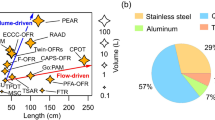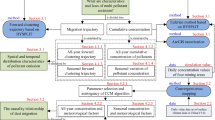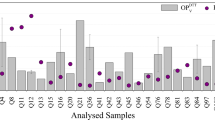Abstract
Sulfate constitutes a significant portion of fine particulate matter (PM2.5) in China, and its formation has been of great interest in the environmental and research community in recent years. In this study, PM2.5 sampling was conducted along with gaseous pollutant concentration measurements and meteorological parameters in the city of Yangquan, China, which has high levels of atmospheric sulfur dioxide (SO2), over the course of four seasons in 2018. PM2.5 levels in daily samples ranged from 20.4 to 250.2 μg m−3, with a mean of 75.1 μg m−3. PM2.5 levels in Yangquan exhibited clear seasonal variations, with the highest seasonal average level of 108.2 μg m−3 found in the winter, likely due to coal combustion for heating purposes, and the lowest level of 45.5 μg m−3 in the summer. The results showed that oxidation by ozone (O3) played a major role in the formation of sulfate in the spring, summer, and autumn, while nitrogen dioxide (NO2) oxidation played a major role in the formation of sulfate in the winter. As a precursor of O3, NO2 also played a key role in its formation. Therefore, controlling NO2 emissions could effectively reduce the formation of sulfate in all four seasons via reductions in O3. Meanwhile, reducing SO2 alone did not effectively decrease sulfate levels when the variations in the concentration of NO2 were small, which indicated the importance of NO2 to the formation of sulfate (SO42−) between 2014 and 2018 in Yangquan. Thus, the control and reduction of NO2 emissions should be strengthened, leveraging existing control efforts of SO2 emissions, in order to most efficiently reduce PM2.5.





Similar content being viewed by others
References
Chen TZ, Chu BW, Ge YL, Zhang SP (2019a) Enhancement of aqueous sulfate formation by the coexistence of NO2/NH3 under high ionic strengths in aerosol water. Environ Pollut 252:236–244. https://doi.org/10.1016/j.envpol.2019.05.119
Chen X, Situ SP, Zhang Q, Wang XM (2019b) The synergetic control of NO2 and O3 concentrations in a manufacturing city of southern China. Atmo Environ 201:402–416. https://doi.org/10.1016/j.atmosenv.2018.12.021
Cheng Y, Zheng G, Wei C, Mu Q (2016) Reactive nitrogen chemistry in aerosol water as a source of sulfate during haze events in China. Sci Adv 2:e1601530. https://doi.org/10.1126/sciadv.1601530
China National Environmental Monitoring Center (2018) National Urban Air Quality Real-time Publishing Platform [EB/OL]. http://113.108.142.147:20035/emcpublish/
Dai QL, Bi XH, Liu BX, Li LW (2018) Chemical nature of PM2.5 and PM10 in Xi’an, China: insights into primary emissions and secondary particle formation. Environ Pollut 240:155–166. https://doi.org/10.1016/j.envpol.2018.04.111
Desouza ND, Blaise D (2020) Impact of aerosols on deep convective clouds using integrated remote sensing techniques. Air Qual Atmos Health 13:815–825. https://doi.org/10.1007/s11869-020-00838-2
Development and Reform Commission of Yangquan (2018) The Implementation for National Economic and Social Development Plan in Yangquan in 2019. http://www.yq.gov.cn/ggsj_12505/tjgb/202003/t20200331_997264.shtml
Eldred RA, Cahill TA, Feeney PJ (1987) Particulate monitoring at US National Parks using PIXE. Nucl Instrum Meth B 22:289–295. https://doi.org/10.1016/0168-583X(87)90344-2
Fang T, Guo HY, Zeng LH, Verma V (2017) Highly acidic ambient particles, soluble metals and oxidative potential: a link between sulfate and aerosol toxicity. Environ Sci Technol 51:2611–2620. https://doi.org/10.1021/acs.est.6b06151
Fang Y, Ye C, Wang J, Wu Y (2019) Relative humidity and O3 concentration as two prerequisites for sulfate formation. Atmos Chem Phys 19:12295–12307. https://doi.org/10.5194/acp-19-12295-2019
Fountoukis C, Nenes A (2007) ISORROPIA II: a computationally efficient thermodynamic equilibrium model for K+–Ca2+–Mg2+–NH4+–Na+–SO42− –NO3− –cl− –H2O aerosols. Atmos Chem Phys 7:4639–4659. https://doi.org/10.5194/acp-7-4639-2007
Gifford FA (1987) Atmospheric chemistry and physics of air pollution. Eos Trans AGU 68:1595–1595. https://doi.org/10.1029/EO068i046p01595-02
Guo S, Hu M, Zamora ML, Peng J (2014) Elucidating severe urban haze formation in China. P Natl Acad Sci USA 111:17373–17378. https://doi.org/10.1073/pnas.1419604111
Guo H, Xu L, Bougiatioti A, Cerully KM (2015) Fine-particle water and pH in the southeastern United States. Atmos Chem Phys 14:5211–5228. https://doi.org/10.5194/acp-15-5211-2015
Guo H, Sullivan AP, Campuzano-Jost P, Schroder JC (2016) Fine particle pH and the partitioning of nitric acid during winter in the northeastern United States. J Geophys Res-Atmos 121:355–310,376. https://doi.org/10.1002/2016JD025311
Hao H, Guo Q (2018) Spatial and temporal characteristics of PM2.5 and source apportionment in Wuhan. IOP conference series: EES 121. https://doi.org/10.1088/1755-1315/121/3/032019
He H, Wang Y, Ma Q, Ma J (2014) Mineral dust and NOx promote the conversion of SO2 to sulfate in heavy pollution days. Sci Rep 4:4172. https://doi.org/10.1038/srep06092
He Q, Guo W, Zhang G, Yan Y (2015) Characteristics and seasonal variations of carbonaceous species in PM2.5 in Taiyuan, China. Atmos 6:850–862. https://doi.org/10.3390/atmos6060850
He Q, Yan Y, Guo L, Zhang Y (2017) Characterization and source analysis of water-soluble inorganic ionic species in PM2.5 in Taiyuan City, China. Atmos Res 184:48–55. https://doi.org/10.1016/j.atmosres.2016.10.008
He P, Alexander B, Lei G, Chi X (2018) Isotopic constraints on heterogeneous sulfate production in Beijing haze. Atmos Chem Phys 18:5515–5528. https://doi.org/10.5194/acp-18-5515-2018
Huang X, Liu Z, Zhang JK, Wen TX (2016) Seasonal variation and secondary formation of size-segregated aerosol water-soluble inorganic ions during pollution episodes in Beijing. Atmos Res 168:70–79. https://doi.org/10.1016/j.atmosres.2015.08.021
Jacob DJ, Hoffmann MR (1983) A dynamic model for the production of H+ NO3−, and SO42− in urban fog. J Geophys Res-Oceans 88:6611–6621. https://doi.org/10.1029/JC088iC11p06611
Jakovljević I, Pehnec G, Vađić V (2018) Polycyclic aromatic hydrocarbons in PM10, PM2.5 and PM1 particle fractions in an urban area. Air Qual Atmos Health 11:843–854. https://doi.org/10.1007/s11869-018-0603-3
Li MH, Fan LC, Mao B, Yang JW (2016a) Short-term exposure to ambient fine particulate matter increases hospitalizations and mortality in COPD: a systematic review and meta-analysis. Chest 149:447–458. https://doi.org/10.1378/chest.15-0513
Li GH, Bei NF, Cao JJ, Huang RJ (2016b) A possible pathway for rapid growth of sulfate during haze days in China. Atmos Chem Phys 17:1–43. https://doi.org/10.5194/acp-17-3301-2017
Li JHY, Zhang YL, Cao F, Zhang WQ (2020) Stable sulfur isotopes revealed a major role of transition-metal ion-catalyzed SO2 oxidation in haze episodes. Environ Sci Technol 54:2626–2634. https://doi.org/10.1021/acs.est.9b07150
Liu X, Sun K, Qu Y, Hu M (2015) Secondary formation of sulfate and nitrate during a haze episode in megacity Beijing, China. Aerosol Air Qual Res 15:2246–2257. https://doi.org/10.4209/aaqr.2014.12.0321
Liu BS, Na S, Dai QL, Mei RB (2016) Chemical composition and source apportionment of ambient PM2.5 during the non-heating period in Tai’an, China. Atmos Res 170:23–33. https://doi.org/10.1016/j.atmosres.2015.11.002
Liu B, Wu J, Zhang J, Wang L (2017a) Characterization and source apportionment of PM2.5 based on error estimation from EPA PMF 5.0 model at a medium city in China. Environ Pollut 222:10–22. https://doi.org/10.1016/j.envpol.2017.01.005
Liu Y, Wu Z, Yu W, Yao X (2017b) Sub-micrometer particles are in the liquid state during heavy haze episodes in the urban atmosphere of Beijing. China Environ Sci Technol Lett 4:427–432. https://doi.org/10.1021/acs.estlett.7b00352
Liu H, Hu ZC, Zhou M, Zhang HH (2020) Airborne microorganisms exacerbate the formation of atmospheric ammonium and sulfate. Environ Pollut 263:114263. https://doi.org/10.1016/j.envpol.2020.114293
Marcazzan GM, Vaccaro S, Valli G, Vecchi R (2001) Characterisation of PM10 and PM2.5 particulate matter in the ambient air of Milan (Italy). Atmos Environ 35:4639–4650. https://doi.org/10.1016/S1352-2310(01)00124-8
Mcardle JV, Hoffmann MR (1983) Kinetics and mechanism of the oxidation of aquated sulfur dioxide by hydrogen peroxide at low pH. J Phys Chem B 87:5425–5429. https://doi.org/10.1021/j150644a024
Meng CC, Wang LT, Zhang FF, Wei Z (2016) Characteristics of concentrations and water-soluble inorganic ions in PM2.5 in Handan City, Hebei Province, China. Atmos Res 171:133–146. https://doi.org/10.1016/j.atmosres.2015.12.013
Ministry of Ecology and Environment of the People’s Republic of China (2015-2019) Bulletin of China’s ecological environment in 2014–2018. http://www.gov.cn/guoqing/2019-04/09/content_5380689.htm
Nair PR, George SK, Sunilkumar SV, Parameswaran K (2006) Chemical composition of aerosols over peninsular India during winter. Atmos Environ 40:6477–6493. https://doi.org/10.1016/j.atmosenv.2006.02.031
Nenes A, Pandis SN, Pilinis C (1998) ISORROPIA: a new thermodynamic equilibrium model for multiphase multicomponent inorganic aerosols. Aquat Geochem 4:123–152. https://doi.org/10.1023/A:1009604003981
Ohta S, Okita T (1990) A chemical characterization of atmospheric aerosol in Sapporo. Atmos Environ Part A General Topics 24:815–822. https://doi.org/10.1016/0960-1686(90)90282-R
Pan XL, Yan P, Tang J, Ma JZ (2009) Observational study of influence of aerosol hygroscopic growth on scattering coefficient over rural area near Beijing mega-city. Atmos Chem Phys 9:7519–7530. https://doi.org/10.5194/acp-9-7519-2009
Qiao T, Zhao MF, Xiu GG, Yu JZ (2015) Seasonal variations of water soluble composition (WSOC, Hulis and WSIIs) in PM1 and its implications on haze pollution in urban Shanghai, China. Atmos Environ 123:306–314. https://doi.org/10.1016/j.atmosenv.2015.03.010
Quan J, Liu Q, Li X, Gao Y (2015) Effect of heterogeneous aqueous reactions on the secondary formation of inorganic aerosols during haze events. Atmos Environ 122:306–312. https://doi.org/10.1016/j.atmosenv.2015.09.068
Russell LM, Ming Y (2002) Deliquescence of small particles. J Chem Phys 116:311. https://doi.org/10.1063/1.1420727
Seinfeld JH (1986) ES Books: Atmospheric chemistry and physics of Air Pollution. Environ Sci Technol 20:863. https://doi.org/10.1021/es00151a602
Stockwell WR, Calvert JG (1983) The mechanism of the HO-SO2 reaction. Atmos Environ 17:2231–2235. https://doi.org/10.1016/0004-6981(83)90220-2
Sun YL, Zhuang GS, Tang AH, Wang Y (2006) Chemical characteristics of PM2.5 and PM10 in haze-fog episodes in Beijing. Environ Sci Technol 40:3148–3155. https://doi.org/10.1021/es051533g
Sun Y, Jiang Q, Wang Z, Fu P (2014) Investigation of the sources and evolution processes of severe haze pollution in Beijing in January 2013. J Geophys Res-Atmos 119:4380–4398. https://doi.org/10.1002/2014JD021641
Sun TL, Zou BB, Huang XF, Shen HY (2019) Source apportionment of PM2.5 pollution in Shenzhen, China. Environ Sci 1:13-20. (in Chinese) https://doi.org/10.19674/j.cnki.issn1000-6923.2019.0002
Tan J, Duan J, Zhen N, He K (2015) Chemical characteristics and source of size-fractionated atmospheric particle in haze episode in Beijing. Atmos Res 167:24–33. https://doi.org/10.1016/j.atmosres.2015.06.015
Tao J, Cheng TT, Zhang RJ (2012) Chemical composition of summertime PM2.5 and its relationship to aerosol optical properties in Guangzhou, China. China Atmos Oceanic Sci Lett 5:88–94. https://doi.org/10.1080/16742834.2012.11446971
Tao J, Zhang L, Engling G, Zhang R (2013) Chemical composition of PM2.5 in an urban environment in Chengdu, China: importance of springtime dust storms and biomass burning. Atmos Res 122:270–283. https://doi.org/10.1016/j.atmosres.2012.11.004
Wang Y, Zhuang G, Tang A, Yuan H (2005) The ion chemistry and the source of PM2.5 aerosol in Beijing. Atmos Environ 39:3771–3784. https://doi.org/10.1016/j.atmosenv.2005.03.013
Wang G, Zhang R, Gomez ME, Yang L (2016) Persistent sulfate formation from London fog to Chinese haze. P Natl Acad Sci USA 48:13630–13635. https://doi.org/10.1073/pnas.1616540113
Wang Z, Ma P, Zhang L (2020a) Systematics of atmospheric environment monitoring in China via satellite remote sensing. Air Qual Atmos Health. https://doi.org/10.1007/s11869-020-00922-7
Wang C, Yan YL, Xie K, Li RM (2020b) Analysis of chemical components and sources of PM2.5 during autumn and winter in Yangquan City. Environ Sci 41:1036-1044. (in Chinese) https://doi.org/10.13227/j.hjkx.201906024
Warneck P (2018) The oxidation of sulfur (IV) by reaction with iron (III): a critical review and data analysis. Phys Chem Chem Phys 20:4020–4037. https://doi.org/10.1039/c7cp07584g
Weber RJ, Guo H, Russell AG, Nenes A (2016) High aerosol acidity despite declining atmospheric sulfate concentrations over the past 15 years. Nat Geosci 9:282–285. https://doi.org/10.1038/ngeo2665
Wu D, Lin SL, Yang, HQ, Du RG (2017) Pollution characteristics and light extinction contribution of water-soluble ions of PM2.5 in Hangzhou. Environ Sci 38:2656–2666. (In Chinese) https://doi.org/10.13227/j.hjkx.201609043
Xia LL, Nowack P, Tilmes S, Robock A (2017) Impacts of stratospheric sulfate geoengineering on tropospheric ozone. Atmos Chem Phys 17:11913–11928. https://doi.org/10.5194/acp-17-11913-2017
Xu Y, Liu H (2020) Spatial ensemble prediction of hourly PM2.5 concentrations around Beijing railway station in China. Air Qual Atmos Health 13:563–573. https://doi.org/10.1007/s11869-020-00817-7
Xu L, Duan F, He K, Ma Y (2017) Characteristics of the secondary water-soluble ions in a typical autumn haze in Beijing. Environ Pollut 227:296–305. https://doi.org/10.1016/j.envpol.2017.04.076
Xue J, Yu X, Yuan Z, Griffith SM (2019) Efficient control of atmospheric sulfate production based on three formation regimes. Nat Geosci 12:977–982. https://doi.org/10.1038/s41561-019-0485-5
Yan Y, Peng L, Li R, Li Y (2017) Concentration, ozone formation potential and source analysis of volatile organic compounds (VOCs) in a thermal power station centralized area: a study in Shuozhou, China. Environ Pollut 223:295–304. https://doi.org/10.1016/j.envpol.2017.01.026
Yang F, He K, Ye B, Chen X, Cha L (2005) One-year record of organic and elemental carbon in fine particles in downtown Beijing and Shanghai. Atmos Chem Phys 5:1449–1457. https://doi.org/10.5194/acp-5-1449-2005
Yue FG, Xie ZQ, Zhang PF, Song SJ (2019) The role of sulfate and its corresponding S (IV) + NO2 formation pathway during the evolution of haze in Beijing. Sci Total Environ 687:741–751. https://doi.org/10.1016/j.scitotenv.2019.06.096
Zhang XY, Gong SL, Shen ZX, Mei FM (2003) Characterization of soil dust aerosol in China and its transport and distribution during 2001 ACE-Asia: 1. Network observations J Geophys Res-Atmos 108:D9. https://doi.org/10.1029/2002JD002632
Zhang Q, Quan J, Tie X, Li X, Liu Q (2015) Effects of meteorology and secondary particle formation on visibility during heavy haze events in Beijing, China. Sci Total Environ 502:578–584. https://doi.org/10.1016/j.scitotenv.2014.09.079
Zhang R, Sun X, Shi A, Huang Y (2018) Secondary inorganic aerosols formation during haze episodes at an urban site in Beijing, China. Atmos Environ 177:275–282. https://doi.org/10.1016/j.atmosenv.2017.12.031
Zhuang GS, Guo JH, Yuan H, Zhao C (2001) The compositions, sources, and size distribution of the dust storm from China in spring of 2000 and its impact on the global environment. Chin Sci Bull 46:895–900. https://doi.org/10.1007/BF02900460
Funding
This work was supported by grants from the National Key R&D Program of China (No. 2019YFC0214200), the National Natural Science Foundation of China (NSFC) (No. 21976053, No. 41673004), the Fundamental Research Funds for the Central Universities (No. 2018ZD12, No. 2019MS042), and Key Project of Heavy Air Pollution Cause and Control (No. DQGG-05-12).
Author information
Authors and Affiliations
Contributions
Cheng Wang: Investigation, formal analysis, writing—original draft, and writing—review and editing
Yulong Yan: Conceptualization, methodology, writing–original draft, and writing–review and editing
Yueyuan Niu, Rumei Li, and Yang Xu: Investigation and formal analysis
Dongmei Hu and Jing Wu: Methodology and validation
Lin Peng: Supervision and project administration
Corresponding author
Ethics declarations
Conflict of interest
The authors declare that they have no conflict of interest.
Additional information
Publisher’s note
Springer Nature remains neutral with regard to jurisdictional claims in published maps and institutional affiliations.
Electronic supplementary material
ESM 1
(DOCX 830 kb)
Rights and permissions
About this article
Cite this article
Wang, C., Yan, Y., Niu, Y. et al. Formation and driving factors of sulfate in PM2.5 at a high-level atmospheric SO2 city of Yangquan in China. Air Qual Atmos Health 14, 491–501 (2021). https://doi.org/10.1007/s11869-020-00953-0
Received:
Accepted:
Published:
Issue Date:
DOI: https://doi.org/10.1007/s11869-020-00953-0




